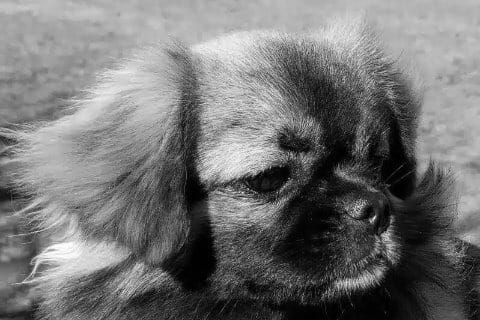
Janet L. Wright | Gembox Tibetan Spaniels
Janet L. Wright shares her journey with Tibetan Spaniels, focusing on breeding for health, temperament, and preserving the breed.
Home » Meet The Breeds » Tibetan Spaniel

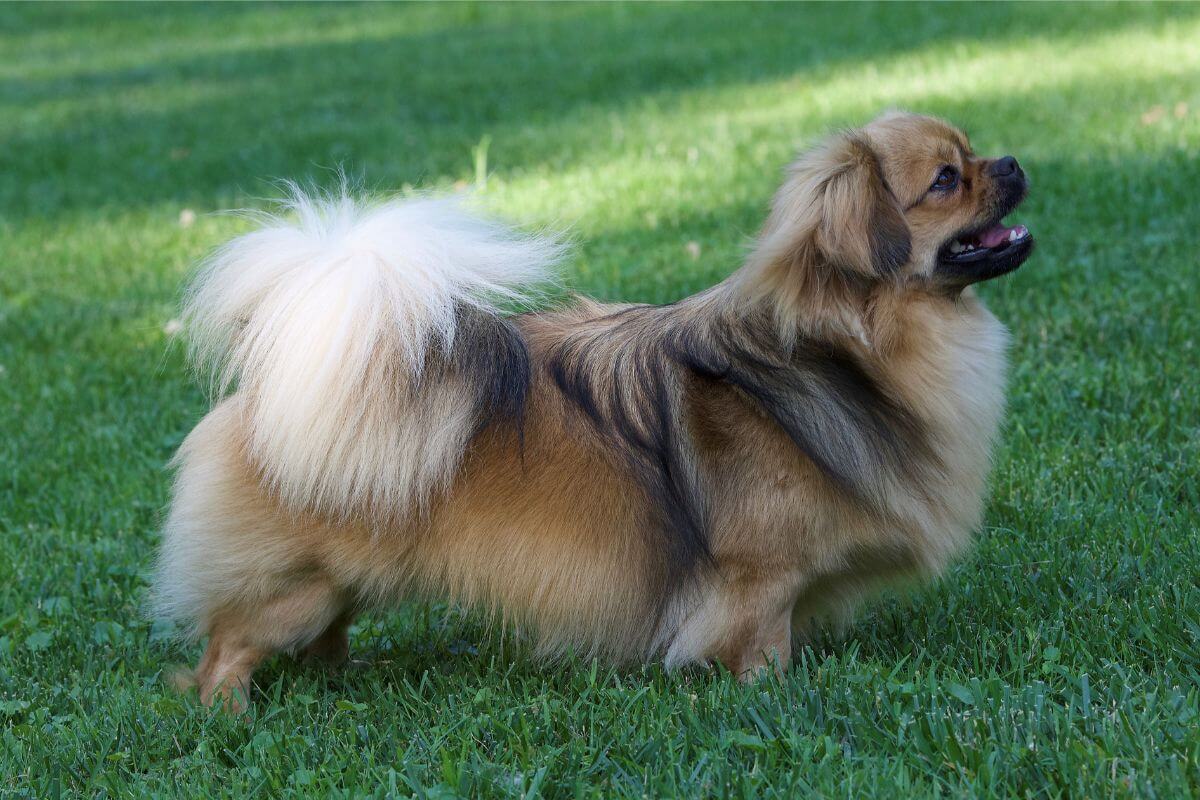
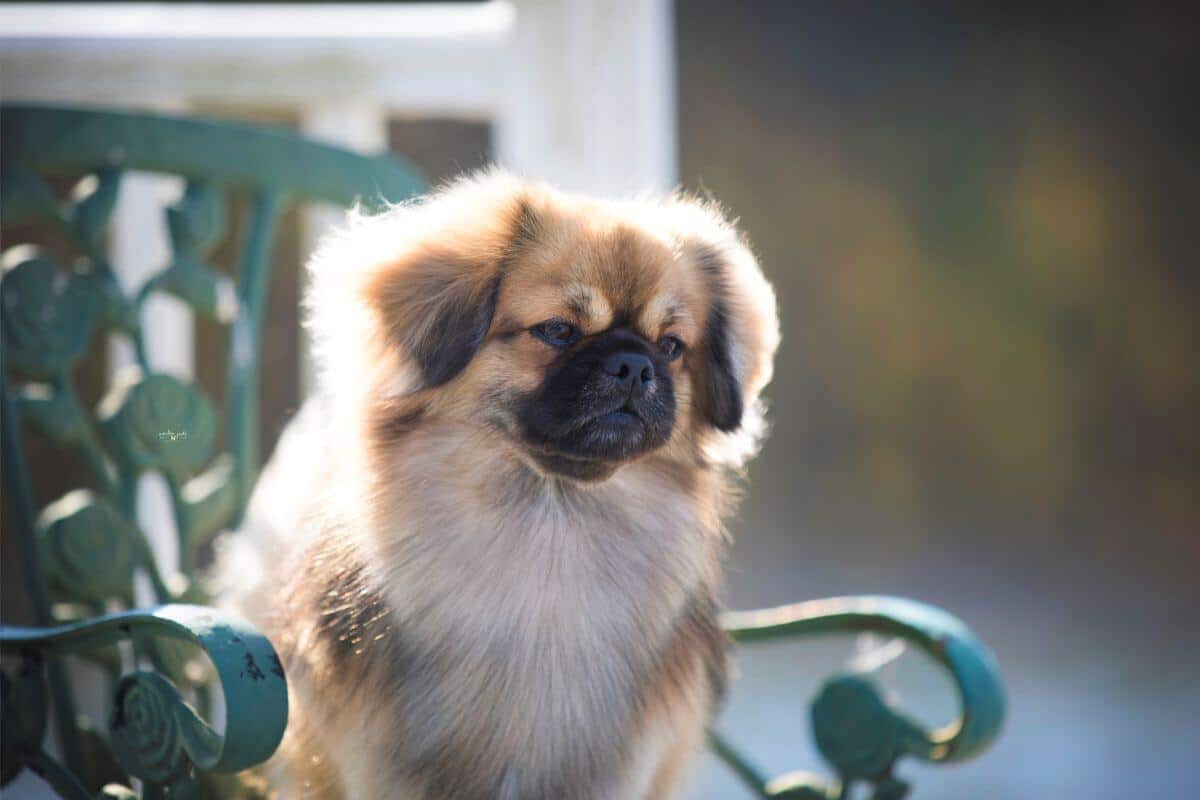

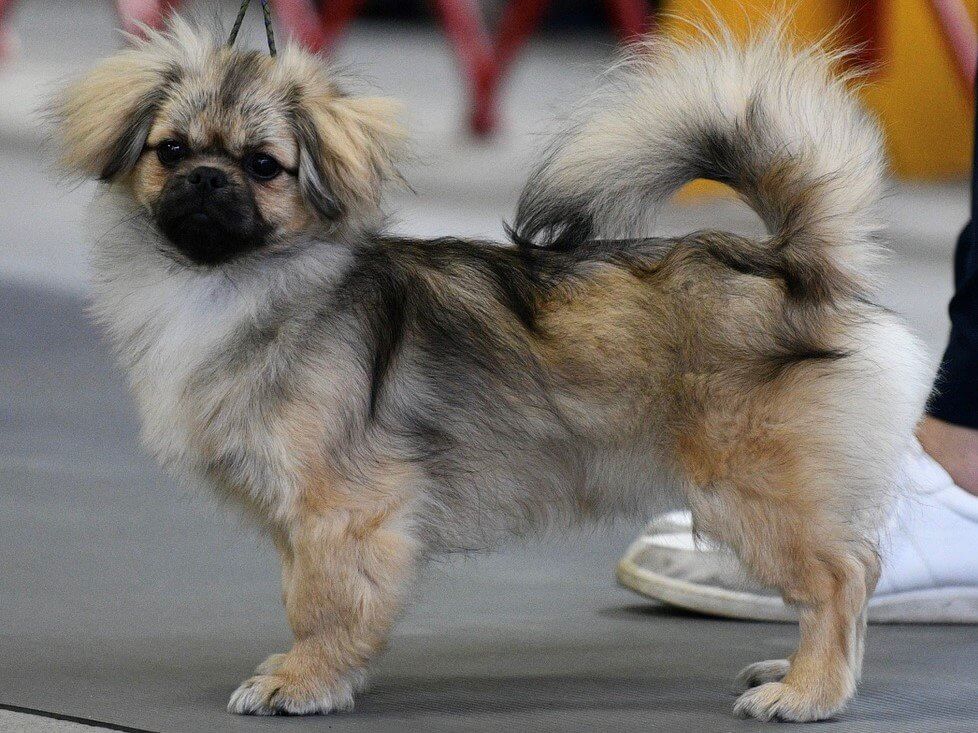
Allan Reznik
The Tibetan Spaniel (or “Tibbie”) is a small, active, and alert little dog. The outline should give a well-balanced appearance, slightly longer than tall. They are a sturdy little dog, enjoy the snow and cold, and there is nothing frail or delicate about them. Tibbies are adaptable, and will be as content in a city apartment as in a large suburban or country home. This breed thrives on human companionship, and for this reason, does not make a good kennel dog. Though they can be aloof with strangers, they are affectionate and devoted to their family and friends. Tibbies are sensitive, and responsive to your moods and feelings. They are alert little watch dogs, and will announce any unusual event or arrival, although they are not considered a yappy breed.
Non-Sporting
10 inches
9 – 15 pounds
12 – 15 years
| Country of Origin | Tibet |
|---|---|
| Bred For | Companionship, Watchdog |
| Known For | Longevity, Moderate Appearance, Charming and Fun Nature |
| Popularity | Low |
| Temperament | Active, Affectionate, Alert, Playful |
| Activities | Conformation Shows, Walking, Dog Sports (Obedience, Agility, Rally) with Owner’s Patience |
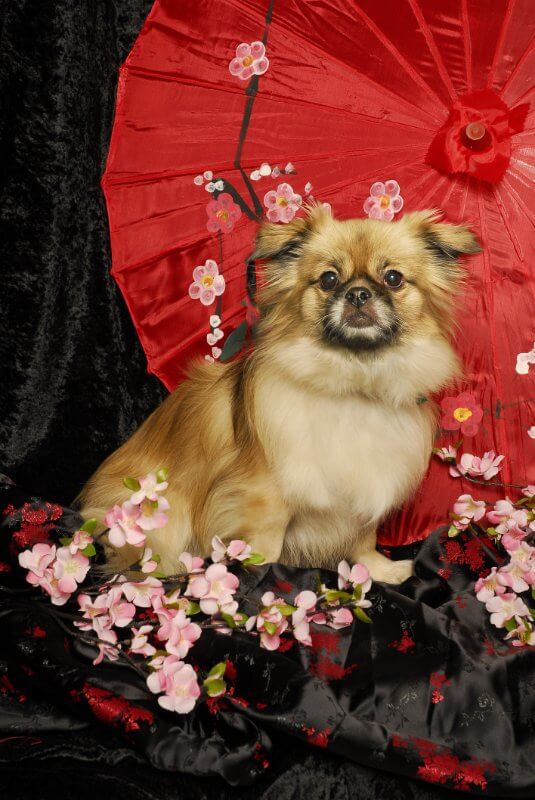
The Tibetan Spaniel comes to us from the Himalayan Mountains of Tibet. The Tibbie has been known for more than 2,000 years. They were bred and owned by the Buddhist monks. Their keen hearing and eyesight made them ideal lookouts, lying on the high monastery walls and barking a warning to the monks and the burly Tibetan Mastiffs on the ground anytime they saw something suspicious. Legend has it that Tibbies were trained to turn the prayer wheels in the monasteries. While this anecdote is questioned today, Tibbies did serve as companions and bed warmers. The Tibetan Spaniels were never sold. They left the monasteries of Tibet only as treasured gifts to esteemed friends.
The misnomer “spaniel” came to be part of their name from the French word “epagneul” which, in the Middle Ages, referred to a companion dog and comforter, much loved by the ladies of the European and Oriental courts. The breed first arrived in England in 1898, but few were bred until after World War II. Importation to the United States began in 1966, and the Tibetan Spaniel Club of America was formed in 1971. The American Kennel Club recognized the Tibetan Spaniel in 1984, and Tibbies joined the Non-Sporting Group.
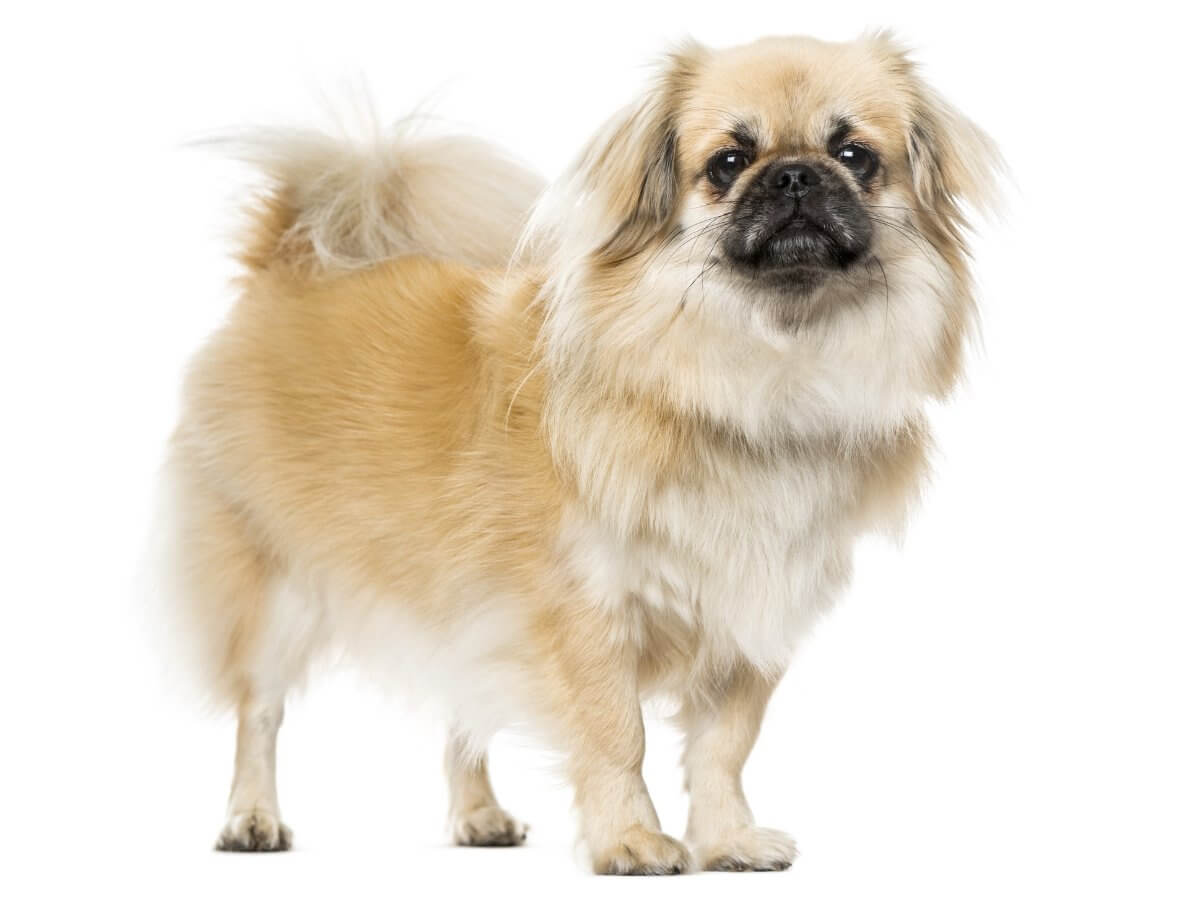
Height is about 10 inches. Weight of 9 to 15 pounds is the ideal.

Body slightly longer from the point of shoulder to root of tail than the height at the withers. Faults: long-bodied, low to the ground, leggy or square. The Breed Standard asks for “moderate bone,” neither coarse and lumbering nor fine-boned and dainty.
Texture: Double coat, silky in texture, smooth on face and front of legs, of moderate length on body but lying rather flat. Ears and back of forelegs nicely feathered, tail and buttocks well furnished with longer hair. Neck covered with a mane or “shawl” of longer hair which is more pronounced on males than females. Feathering on toes often extends beyond the feet. Should not be over-coated and females tend to carry less coat and mane than males.
| Standard Color | |
|---|---|
| Black | ee |
| Black & Tan | ee |
| Cream | ee |
| Gold | ee |
| Red | ee |
| Sable | ee |
| Silver Sable | ee |
| White | ee |
| Standard Marking | |
|---|---|
| Parti-Color | ee |
| White Markings | ee |
A Note About Color: All colors and mixtures of colors are allowed. Colors and patterns most frequently seen are shades of gold, fawn, red, and cream, with or without sabling (black overlay or hairs tipped with black); black and tan; tricolor; all black, all white. Chocolate (brown), with or without tan markings, do occur, but because this dilute color comes with liver nose and eye rims, and the Breed Standard requires black pigment, chocolate is discouraged.
Black masks are common. Black and tan (and tricolor) dogs have tan markings (points) over the eyes, on the cheeks, chest, feet, and under the tail. Sabling (black tips to the hairs) are common in the gold and fawn shades.
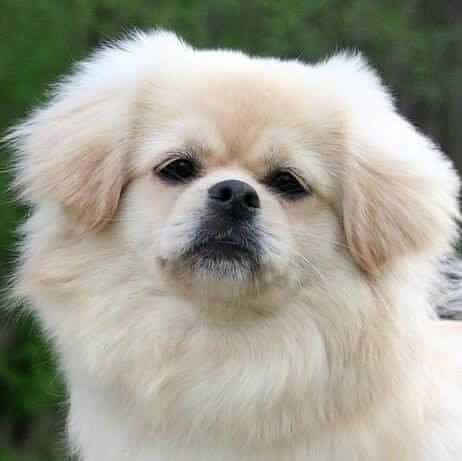
The Tibetan Spaniel is a charming little breed, long lived, and often called the “best-kept secret in the dog world.” Because they are moderate in all respects, and without the exaggerations that have affected many other breeds, there has never been a period of explosive popularity for the breed, which has been a benefit. Prospective owners need to remember that Tibbies are stubborn, may obey commands under protest, and must never be exercised off leash in an unfenced area.
Tibbies are a rugged little breed, as one would expect coming from the Himalayan Mountains, with relatively few health concerns. Slipping patellas (knee caps) can afflict many smaller breeds, including the Tibetan Spaniel. Eye exams are also recommended.
Lifespan: Tibetan Spaniels will often live into their middle to late teens. They age well and maintain a joyful attitude
from puppies to senior citizens.
While a very healthy breed, OFA recommends that Tibbies receive an ACVO Eye Exam, and a Progressive Retinal Atrophy (PRA) DNA test. Patellar Luxation or slipping/popping kneecaps can affect Tibbies, as well as many other smaller breeds. Tibbies were originally bred to perch on the tops of monasteries and survey the activities below, and today they still love to climb up on window sills, chairs, and furniture. Because they are longer than they are tall, keep an eye on their jumping to prevent a fall or back injury.
Tibbies are very intelligent with excellent problem-solving skills. However, they have an independent streak which makes training them a challenge. Pleasing you is not a high priority for them, so you’ll have to find ways to convince them that obeying commands was their idea. They adore their families but can be rather aloof with strangers. This will vary from dog to dog; some are more outgoing than others. Observe your puppy’s parents and also ask how the breeder socialized the litter before they were ready to go to their new homes.
Tibbies typically have good appetites and few issues when it comes to eating. Choose a good-quality food, and follow your veterinarian’s and breeder’s advice on how much to feed. Tibbie faces are hard to resist, so guard against offering too many between-meal snacks and letting your Tibbie pack on the pounds.
Tibbies are very clean, so crating your puppy when you cannot supervise him, and taking him out regularly, will facilitate house-training. Early and ongoing socialization is important to expose your Tibbie to adults, kind children, and other dogs and cats. Puppy Kindergarten classes are widely available and a fun way to teach your Tibbie basic commands in an environment of distractions. Tibbies should never be let off leash outdoors in an unfenced area. They are too stubborn and too curious about the world around them to take that risk.
This is a very adaptable breed, as happy in a high-rise studio apartment as in a big suburban or country home. They are just as adaptable in their exercise needs. A Tibetan Spaniel will do fine with a 30-minute walk and playing with toys in the house, but will also enjoy a few hours of hiking with a more outdoorsy owner. Tibet can get bitterly cold, and Tibbies will happily frolic in the snow.
| Energy Level | Moderate |
|---|---|
| Exercise Requirements | 1 Hour/Day (Minimum), Daily Walks, Vigorous Running, Regular Exercise, Mental Stimulation |
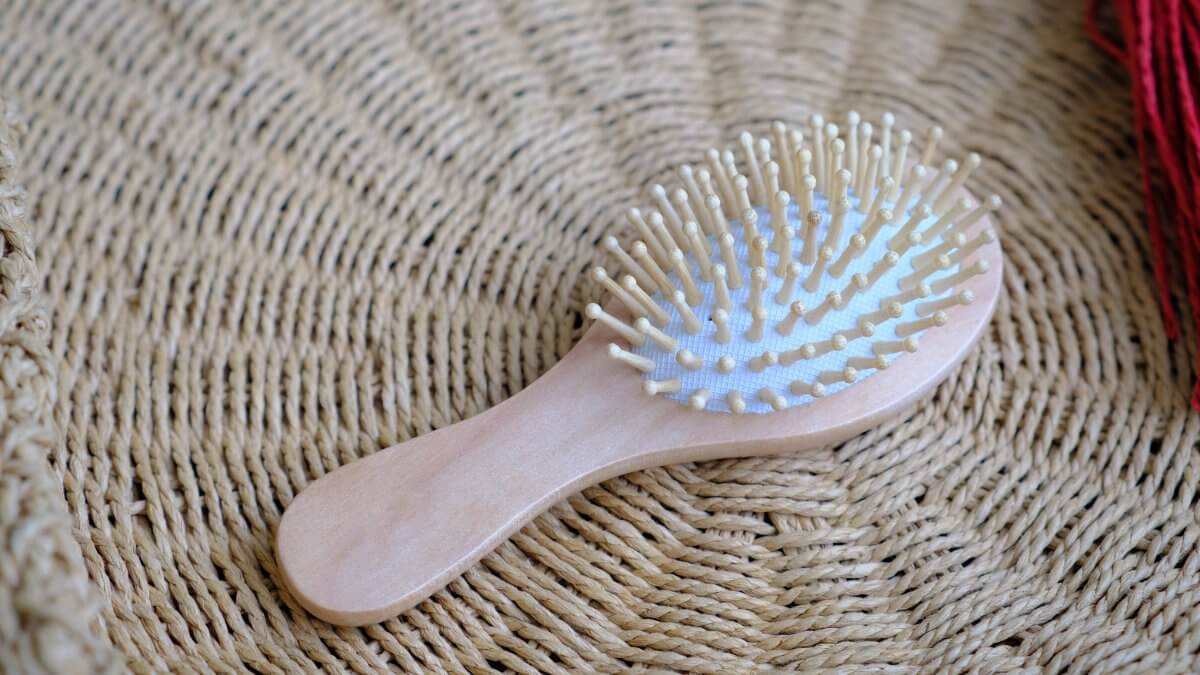
While a coated breed, the Tibetan Spaniel is easily groomed. Tibbies are double-coated, with a soft undercoat and a silky outer coat. Weekly brushing will keep your Tibbie well maintained, but lift the coat up with your left hand to be sure you are brushing in layers to the skin. Use a comb to carefully check for tangles and mats behind the ears, in the armpits, under the tail and in the longer breeches or pantaloons behind the rear legs. Spayed and neutered Tibbies will develop a thicker, woollier coat, but pet owners can keep them well maintained with regular, thorough brushing, although you may choose to take your Tibbie to a professional groomer. Trimming and scissoring are not needed, beyond keeping the foot hair between their pads cut short.
| Coat Type | Double, Medium length |
|---|---|
| Grooming Requirements | Weekly brushing. Gently comb out mats and tangles behind the ears, elbows, feet, and hindquarters. Regular ear cleaning, tooth brushing, and nail trimming. |
The Tibetan Spaniel is an adaptable, sturdy little dog that will be as content in a city apartment as in a large suburban or country home. Tibbies thrive on human companionship, and for this reason they do not make a good kennel dog. They can be aloof with strangers but are affectionate and devoted to their family and friends. Tibbies are sensitive, and responsive to the moods and feelings of their people. They are alert little watch dogs that will announce any unusual event or arrival. They’re not, however, considered a yappy breed.
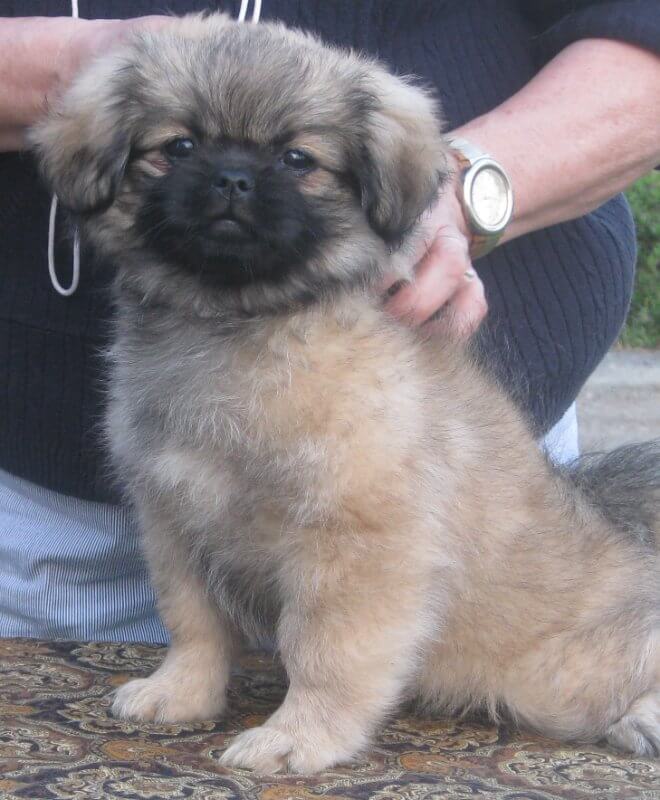
Think of your puppy as an infant. Tibbie babies need a routine, with regular meals, naps, playtime, and potty breaks. Although children will be attracted to their cuddly size and sweet faces, Tibbies need a home that is safe, and to be protected from teasing and rough handling. A cozy crate with a blanket and toys, will ensure secure off-leash confinement. Get your puppy accustomed to weekly grooming, nail trimming, and ear and eye cleaning. It’s important to keep up the good habits and routines that your puppy’s breeder has probably begun.
Tibetan Spaniels are great fun to show in Conformation, if that is an interest of yours. Most all-breed kennel clubs offer inexpensive handling classes, where both you and your Tibbie will learn the ropes and make friends with other show-minded owner-exhibitors.
Agility and Rally are fast-paced performance events that your Tibbie might enjoy. Think of them as obstacle courses, complete with tunnels, weave poles, and teeter totters.
If you prefer something less formal, organize regular on-leash walks and hikes with dog-owning friends to keep everyone fit. Once you’re home, your Tibbie will happily keep you company on the couch while you read or watch TV.
The Tibetan Spaniel is recognized by the world’s leading registries and kennel organizations, which categorize the breed into a specific Group based on its unique characteristics. This breed is recognized worldwide under the following Group designations:
| Organization | Group Designation |
|---|---|
| AKC (American Kennel Club) | Non-Sporting |
| UKC (United Kennel Club) | Companion Dog |
| CKC (Canadian Kennel Club) | Non-Sporting |
| ANKC (Australian National Kennel Council) | Toys |
| RKC (The Royal Kennel Club) | Utility |
| FCI (Fédération Cynologique Internationale) | Group 9, Companion and Toy Dogs; Section 5: Tibetan Breeds |
The ideal Tibetan Spaniel is described by a Breed Standard that is approved by each of the world’s leading registries and kennel organizations. The Breed Standards for this breed may be found in the following links:
| Organization | Breed Standard |
|---|---|
| American Kennel Club | AKC Tibetan Spaniel Breed Standard |
| United Kennel Club | UKC Tibetan Spaniel Breed Standard |
| Canadian Kennel Club | CKC Tibetan Spaniel Breed Standard |
| Australian National Kennel Council | ANKC Tibetan Spaniel Breed Standard |
| The Royal Kennel Club | RKC Tibetan Spaniel Breed Standard |
| Fédération Cynologique Internationale | FCI Tibetan Spaniel Breed Standard |
Tibetan Spaniel Club of America, https://www.tsca.ws
The TSCA holds an annual national specialty (a dog show just for Tibbies) in different parts of the country. The club publishes an informative quarterly newsletter, has an active presence on Facebook, and offers an online chat group to members.
Canada: It appears there is not an active parent club at this time—per Google search and a search of the CKC website.
UK Tibetan Spaniel Association, https://tibetanspanielassoc.co.uk
Tibetan Spaniel Club of America Rescue & Health Trust; info@tstrust.org
https://tibetanspanielassoc.co.uk/breed-rescue
The Buddhist monks claimed the Tibetan Spaniel was 1/3 dog, 1/3 cat, and 1/3 monkey. Given the Tibetan Spaniel’s stubborn streak, mischief, sense of humor, and habit of washing other dogs’ faces, this description is entirely accurate.
Definitely not. This breed is too stubborn, independent, and easily distracted. Keep your Tibbie safe with on-leash exercise or off-leash in a fenced yard.
No. Although some owners take their dog to a groomer, the Tibbie is an easy-care breed, and most owners can keep their dogs well maintained with weekly grooming, and regular nail, eye and ear care. Longer, woollier coats on spayed/neutered dogs may be more challenging.
No dog breed is 100 percent hypoallergenic. Tibbies do shed. If you have allergies, visit a Tibbie owner at home and see how you react to the coat.
Tibbies were bred as watch dogs, and will bark if there is something they feel you need to know about, or if they hear an unusual noise. They will also sometimes vocalize when playing. However, they are not considered yappy.
As much or as little as you provide. Avoid over-exercising a puppy under 12 months. Once fully grown, they are fine with a 30-minute walk or a five-mile hike. Tibbies are highly adaptable.

Although Allan Reznik has worn many hats in the dog show world over the past 50 years, he is probably best known as an award-winning journalist and broadcaster. He was the Editor-in-Chief of Dogs in Canada, Dog World, Dog Fancy and Dogs in Review magazines. All four publications received national honors from the Dog Writers Association of America while under his stewardship. Reznik appears regularly on national TV and radio to discuss the dog show sport as well as all aspects of responsible animal ownership. He has bred and shown champion Afghan Hounds, Cavalier King Charles Spaniels and Tibetan Spaniels. He is currently an approved AKC judge of all three breeds, as well as a provisional/permit judge of 11 additional breeds.

Janet L. Wright shares her journey with Tibetan Spaniels, focusing on breeding for health, temperament, and preserving the breed.

Lynn Miller is the breeder behind Kofuku Tibetan Spaniels. Read about the kennel’s beginnings, puppies, and much more!
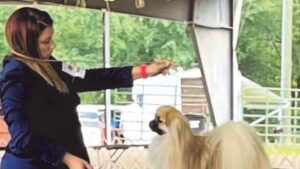
Marybeth Acker is the breeder behind MacIain Tibetan Spaniels. Read about the kennel’s beginnings, Tibetan Spaniel puppies, and much more!
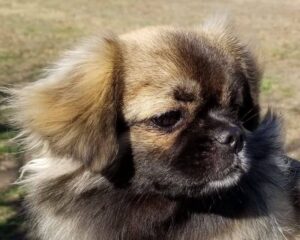
Carol Zieris is the breeder behind the Primah Tibetan Spaniels. Read about the kennel’s beginnings, champions, dogs, puppies, and more!
The best way to ensure a long and happy relationship with a purebred dog is to purchase one from a responsible breeder. Not sure where to begin?
Contact the National Parent Club’s Breeder Referral Program, which is listed on the AKC Breeder Referral Contacts page.
